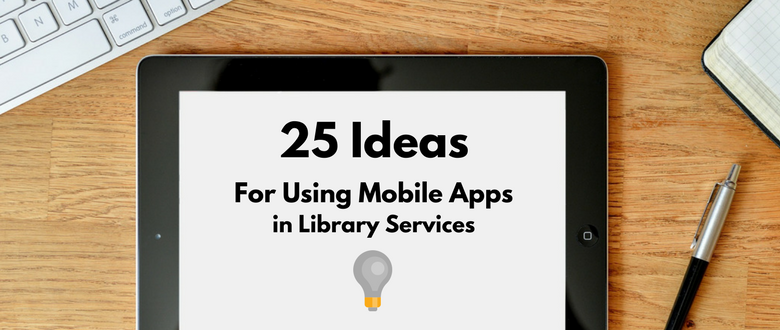In my online course, “Apps for Librarians,” one of the assignments is to participate in a brainstorming activity about this topic.
Librarians in my course are from many types of libraries (public, academic, school, and special), and this list is based on ideas they came up with.
25 Ideas
-
- Use iPads for story time using interactive picture book apps. Pair up caregivers and kids to read together or project the app on a big screen. Have events where teens read to the young kids with iPad apps.
-
- Introduce graphic novels both print and for mobile devices, do presentation about them with iPad and projector.
-
- Have an app share event – everyone shares apps that have been helpful to them. Librarians provide a list of apps to start with. Call this “Appy Hour.”
-
- Have classes for parents on the best apps for kids of different age levels.
-
- Hold info sessions on interactive book apps to show people what’s available.
-
- Host app clubs – like book clubs, but for apps.
-
- Create presentations for specific departments at your university about the best apps for their field.
-
- Create outreach programs for residents of nursing homes. Use content creation apps where seniors can tell their life story and interviews can be captured. Do presentations about specific times in history, using apps about the topic.
-
- Offer a session on apps for job-searching and networking.
-
- Have instruction and liaison librarians explore and review apps that are relevant to their departments and subject areas. Create a display (online or offline) with images, descriptions and links to the apps.
-
- The library itself (or a consortium of libraries) could become a publisher of local digital content using iBooks Author to create interactive books, or act as a host for self-published ebooks by their community members.
-
- Create local history apps that contain video interviews, maps and photos – everything about the history of the local community.
-
- Offer a collection of interactive book apps on iPads for loaning either inside the library, or as take-home devices.
-
- Collect and categorize the best reference apps and put them on the iPads used by reference librarians. Use these reference apps to answer questions.
-
- Purchase print books that can be used with specific apps (augmented reality books), and make the iPad, the app, and the book available together.
-
- Provide tablet stations where people can use tablets pre-loaded with excellent apps in different topic areas.
-
- Offer relevant apps in your makerspace – apps that help with 3D printing and design.
-
- Contribute app reviews to the professional literature. (See App Review Checklist, free PDF).
-
- Include apps in bibliographies along with other types of resources.
-
- Review apps in library-related blogs.
-
- Offer a program for young adults where teens come to record and edit their own movies. Use iPads and iPhones with the iMovie app for their recording and editing needs, instead of more expensive laptops and video cameras.
-
- Introduce the Scanbot app to genealogy society members who meet at the library as a way to scan their research treasures into their devices and reduce the amount of paper they have.
-
- Use the Kindle app or the Overdrive app for readers with dyslexia. These apps offer the OpenDyslexic font. According to opendyslexic.org, the font helps dyslexic readers distinguish letters and words for easier reading. Features include weighted bottoms for each letter to help indicate letter direction and wider letter spacing.
-
- Use a comic strip creation app with kids for a project to create their own comic strips. They can work alone or in groups to tell their stories. The activity promotes creativity, collaboration, and lets them come away with a digital comic strip that they can share with others.
-
- Offer a “Student Success Workshop” in order to introduce useful apps such as Dropbox, 1Password, Wunderlist, Evernote, and JotNot. Also show examples of using Apple’s and Google’s apps for word processing and slide creation, for ease of creating required papers, presentations, and collaborative group work.
Do you have more ideas?
Share them by commenting on this post. Tell us what you’re doing with mobile apps in your library programs.
Want to learn more? Join the Apps for Librarians course!
